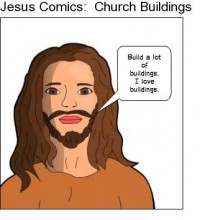I believe that Jesus was crucified on Thursday instead of Friday. The following post explains why. I must hasten to add, however, that it is not super important to know for sure the day on which Jesus died. What is most important is to know that He died.
The day on which Jesus died is not nearly as important as the fact that He did die.
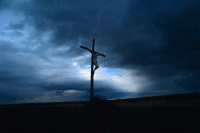 Church tradition states that Jesus was crucified on a Friday. This is why we call it “Good Friday.”
Church tradition states that Jesus was crucified on a Friday. This is why we call it “Good Friday.”
Friday Crucifixion
The main reason for this tradition, as far as I can tell, is that the disciples of Jesus were intent upon burying Jesus before the Sabbath arrived (Mark 15:42-43; Luke 23:54; John 19:31). As most people equate the Sabbath with Saturday, it is believed that Jesus was crucified on Friday.
The primary problem with this, however, is that Jesus said He would spend three days and three nights in the grave (Matt 12:40). Many historians rightfully point out that by Jewish reckoning, any portion of a day was considered the whole day, this explanation still does not get us to three days and three nights.
Traditional Counting
Day 1: Jesus was crucified and buried on Friday before the sunset.
Night 1: He stayed in the grave Friday night.
Day 2: Saturday.
Night 2: Saturday night.
But this is all we can get. John 20:1 says that Jesus rose before sunrise on Sunday, when it was still dark. This means we cannot get a third day, let alone a third night. Some scholars say that since Jewish days actually begin at sundown, then any portion of that twenty-four hour period from sundown to sundown counts as the entire “day and night.”
Only in this way can scholars have Jesus in the tomb for three “days and nights.” He was in the tomb before sundown on Friday, which counts as Thursday night (night 1) and Friday day (day 1). Then He spends Friday night (night 2) and all day Saturday (day 2) in the tomb. Finally He rises before sunrise on Sunday, which counts for both Saturday night (night 3) and Sunday day (day 3). So even though Jesus was not in the tomb for any portion of Thursday night or Sunday day, they still get counted.
This explanation seems highly unlikely, especially when a much simpler solution is available. What is that solution?
Jesus was crucified on Thursday
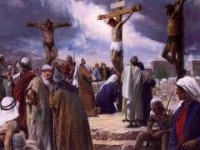 But if Jesus was crucified on Thursday, then the next day was not the Sabbath, right? Wrong. John 19:31 clearly tells us that this particular Sabbath was a High Day. In other words, it was not a weekly Saturday Sabbath, but was a special holiday Sabbath.
But if Jesus was crucified on Thursday, then the next day was not the Sabbath, right? Wrong. John 19:31 clearly tells us that this particular Sabbath was a High Day. In other words, it was not a weekly Saturday Sabbath, but was a special holiday Sabbath.
Readers of the Gospels must understand that there are two kinds of Sabbaths in Jewish years. There is the weekly Sabbath, which always begins on Friday night and continues all day Saturday until sunset. That is the Sabbath those most of us are aware of.
There is also a second type of Sabbath: the holiday Sabbath. It does not fall on a particular day of the week, but on a particular day of the year. Whichever day of the week this holiday falls on is treated like a Sabbath. Think of it like a Federal Holiday. While most Federal offices are closed every Sunday, they will also close on holidays like Christmas, on whichever day of the week it occurs.
This is what happened the year Jesus was crucified. It was the week of Passover, and the first day of Passover, which on the Jewish calendar is Nisan 15, is a holiday Sabbath, on whichever day of the week it occurs. That year, it fell on a Friday, which means that the holiday Sabbath of Passover began Thursday night.
This then, is the order of events:
Wednesday night: Last Supper in the Upper Room, and the arrest in Gethsemane
Thursday morning: Conclusion of Trials and Crucifixion
Thursday afternoon: Death and Burial. Counting of days now begins.
Thursday Day: Day 1
Thursday night: Night 1
Friday Day: Day 2
Friday Night: Night 2
Saturday Day: Day 3
Saturday Night: Night 3
Jesus rises before sunrise, so as not to start Day 4.
Three other points of evidence for this view:
- We no longer have a “Silent Wednesday.” Most chronologies of the final week of Jesus have a void on Wednesday, because the Gospels seem to say nothing about this day. But maybe the Gospels are not silent at all, and it is our order of events that is confused.
- Jesus was technically in the grave for two consecutive Sabbaths, the holiday Sabbath and then the regular, weekly Sabbath. This fits with Matthew 28:1 which says that the two women came to the tomb where Jesus was buried after the Sabbaths (Plural. In Greek: sabbatōn) were over.
- Edit (From Matt Aznoe on my Facebook page): One other point of evidence that is interesting is Palm Sunday. If Jesus was crucified on Thursday (Nisan 14), that would place Palm Sunday on Nisan 10 which is the day set forth in the original Passover law as the day that the people chose their Passover Lamb. The imagery then is striking — on the day that the Passover Lamb is chosen, the people of Jerusalem cry “Hosanna” as the Lamb of God rides in on a donkey. (Thanks Matt!)
This still does not solve the problem of why Jesus celebrated the Passover a day early, but that is still a difficulty whether you believe Jesus died on Thursday or Friday (cf. Matt 26:17; Mark 14:12-16; Luke 22:1, 7-8; and John 18:29; 19:14).
For more on this issue, see these articles:
The cross of Jesus is CENTRAL to everything!
Transform your life and theology by focusing on the crucifixion and resurrection of Jesus:
Fill out the form below to receive several emails from me about the death and resurrection of Jesus.
(Note: If you are a member of RedeemingGod.com, login and then revisit this page to update your membership.)


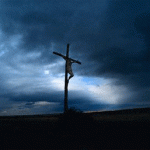
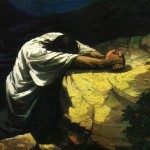
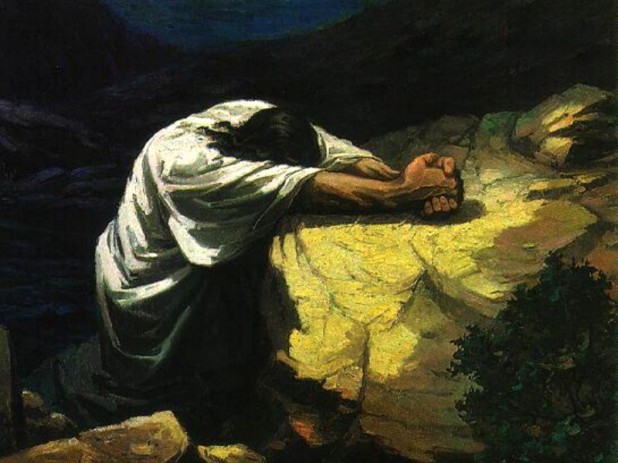
 Part of the problem is that we do not understand the Passover imagery which Jesus was using. Jesus and the apostles had just come from eating their Passover meal, during which time they would have drunk deeply from four cups of wine. At that time, the table would usually share one, large, communal cup. The custom was that when the cup came to the place you were reclining, you must drink from it as deeply as you could, before passing it on to the next person at the table.
Part of the problem is that we do not understand the Passover imagery which Jesus was using. Jesus and the apostles had just come from eating their Passover meal, during which time they would have drunk deeply from four cups of wine. At that time, the table would usually share one, large, communal cup. The custom was that when the cup came to the place you were reclining, you must drink from it as deeply as you could, before passing it on to the next person at the table.
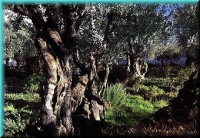
 Though we can never know the spiritual agony that Jesus experienced on the cross, we see hints of it in what He says. For example, His fifth statement from the cross is “My God, My God, Why have you forsaken me?” Jesus, as the second person of the Trinity, has had constant fellowship with God the Father for all eternity. What must it have been like for Him now to have that relationship severed and broken? What must it have felt like for Jesus when our sin separated Him from God? Our sin broke the eternal fellowship of the Godhead!
Though we can never know the spiritual agony that Jesus experienced on the cross, we see hints of it in what He says. For example, His fifth statement from the cross is “My God, My God, Why have you forsaken me?” Jesus, as the second person of the Trinity, has had constant fellowship with God the Father for all eternity. What must it have been like for Him now to have that relationship severed and broken? What must it have felt like for Jesus when our sin separated Him from God? Our sin broke the eternal fellowship of the Godhead!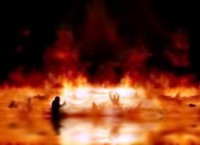 Scholars widely disagree about what happened to Jesus after He died. Some believe He
Scholars widely disagree about what happened to Jesus after He died. Some believe He 


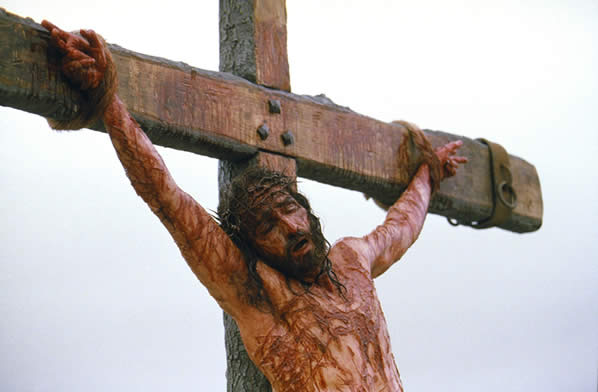
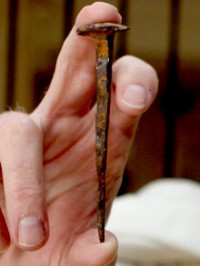 If the authorities wanted a quicker death, they would generally drive nails into the hands and feet of the victim. The nails were not driven into the palms of the hands as most pictures show. Rather, they were driven through the wrist near the hands. If the spikes were driven through the hands, the weight of the person would cause the nail to rip through the hands and the victim would fall off the cross. But when driven through the wrist, the set of bones which attach the wrist to the hand keep the hands from ripping free.
If the authorities wanted a quicker death, they would generally drive nails into the hands and feet of the victim. The nails were not driven into the palms of the hands as most pictures show. Rather, they were driven through the wrist near the hands. If the spikes were driven through the hands, the weight of the person would cause the nail to rip through the hands and the victim would fall off the cross. But when driven through the wrist, the set of bones which attach the wrist to the hand keep the hands from ripping free.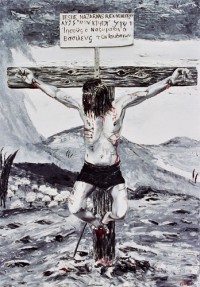 To take a breath, the victim would have to stand up on the nail through his feet, causing excruciating pain in the feet, but enabling him to take a breath. As long as he was putting all his weight on his feet, he could breathe. But when that became too painful, he would slump back down, putting all his weight on his wrists, and also returning to the condition of not being able to breathe.
To take a breath, the victim would have to stand up on the nail through his feet, causing excruciating pain in the feet, but enabling him to take a breath. As long as he was putting all his weight on his feet, he could breathe. But when that became too painful, he would slump back down, putting all his weight on his wrists, and also returning to the condition of not being able to breathe.
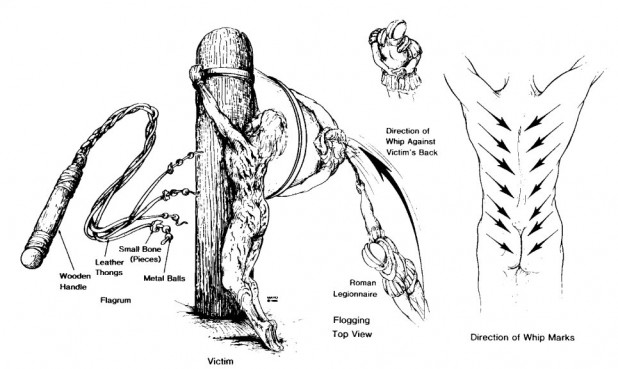
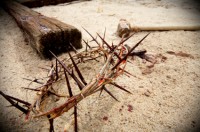 The half-fainting Jesus is then untied and allowed to slump to the stone pavement, soaked with His own blood. The Roman soldiers see an opportunity to make a joke out of Him. Here is a provincial Jew claiming to be a king, but was now barely alive. So they throw a robe across His shoulders and place a stick in His hand for a scepter. To make the travesty complete, a small bundle of flexible branches covered with long thorns are woven into the shape of a crown and pressed into His scalp. Since head wounds always bleed a lot, the blood runs down His face and into His eyes.
The half-fainting Jesus is then untied and allowed to slump to the stone pavement, soaked with His own blood. The Roman soldiers see an opportunity to make a joke out of Him. Here is a provincial Jew claiming to be a king, but was now barely alive. So they throw a robe across His shoulders and place a stick in His hand for a scepter. To make the travesty complete, a small bundle of flexible branches covered with long thorns are woven into the shape of a crown and pressed into His scalp. Since head wounds always bleed a lot, the blood runs down His face and into His eyes.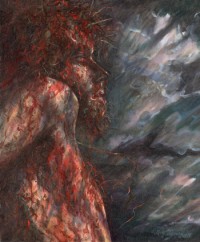 Most artists do not even come close in depicting what Jesus looked like after all of this torture. He was probably the most inhuman looking thing you’ve ever seen. The prophet Isaiah wrote of the Messiah: “They shall see the Servant of God beaten and bloodied, an object of horror; so disfigured many were astonished. His face and His whole appearance were marred more than any man’s, one would scarcely know it was a person…” (Isa 52:14).
Most artists do not even come close in depicting what Jesus looked like after all of this torture. He was probably the most inhuman looking thing you’ve ever seen. The prophet Isaiah wrote of the Messiah: “They shall see the Servant of God beaten and bloodied, an object of horror; so disfigured many were astonished. His face and His whole appearance were marred more than any man’s, one would scarcely know it was a person…” (Isa 52:14).
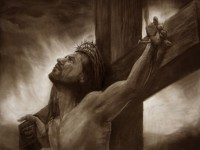 His mission of atonement is nearly complete. Finally, He can allow His body to die. With one last surge of strength, He presses His torn feet against the nail, straightens His legs, looks into heaven, and utters His seventh and last cry, “Father, into your hands I commit my spirit.”
His mission of atonement is nearly complete. Finally, He can allow His body to die. With one last surge of strength, He presses His torn feet against the nail, straightens His legs, looks into heaven, and utters His seventh and last cry, “Father, into your hands I commit my spirit.”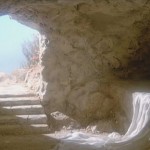
 The differences between Christmas and Easter could be told as The Tale of Two Fridays.
The differences between Christmas and Easter could be told as The Tale of Two Fridays.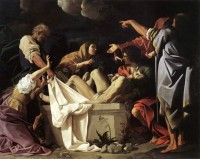

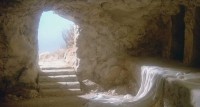
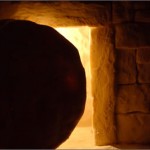



 As I was doing research for one of the books I’m writing, I stumbled across the statistic that the average pastor’s salary in the United States is over…
As I was doing research for one of the books I’m writing, I stumbled across the statistic that the average pastor’s salary in the United States is over…
